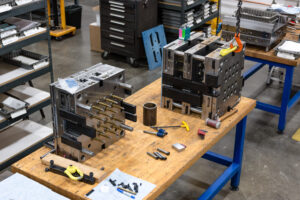Intro
Insert molding is a very common way of adding metal features to a plastic, mass-produced part. The result is a combination of the two materials in a reliable way. If you’re curious about this process, you came to the right place.
In this guide, our experts will describe how insert molding works. We’ll provide some tips and explanations to help you get the best results on your next insert molding project.
What Is Insert Molding?
To put it simply, insert molding is when you add a metal part to your injection-molded unit. It’s done before molten plastic is poured into the mold, and it becomes fused with the plastic part.
Typically, you’ll see insert molding done as a way to add a metal threaded insert into a plastic part, like in an electrical wire nut that you twist onto pairs of exposed wires — the center of the part is metal, while the outside is plastic.
You can find a lot of examples of insert molding that’s used in aerospace, medical, and consumer products, to name a few industries.
As you probably know, plastic threads are prone to failure and stripping, especially as the part is threaded and unthreaded multiple times. Metal threads, on the other hand, can last for much longer. This is why it makes sense to use insert molding for parts that need to be routinely disassembled.
The Process of Insert Molding
How does the insert molding process work? Our experts describe the process using the following 5 steps.

Step 1: Load the Inserts into the Mold
Before molten plastic starts flowing, you need to place the metal insert in position. The component needs to sit properly and maintain its position during the injection molding process, so the mold needs to be fabricated and designed to house this insert.
The insert can be added either manually or through automation, like using a robot to load the inserts. In either case, the insert needs to be placed precisely.
Step 2: Inject the Molten Plastic
With the inserts in place, you can perform a standard injection process. Add in molten plastic at high pressures to fill the mold (just like you would in a standard injection molding project).
Step 3: Remove the Molded Part
The next step is to open the mold and remove your part. Of course, you’ll need to wait long enough for the part to cool and solidify. For insert molding, you’ll typically wait a little longer to ensure the plastic solidified around your metal insert so the insert doesn’t fall out after use.
Step 4: Separate the Molded Part from the Sprue
Your injection-molded part probably has designed sprues on it, which act as a reinforcing framework to keep the part solid and rigid during the injection process. After you remove the part, you’ll need to get rid of these sprues and trim any additional flashing.
During this step, you can examine the metal insert to make sure it is correctly seated and bonded to the plastic surrounding it.
Step 5: Do Post-Processing Steps
Now you’re free to do any post-processing steps like adding a surface finish, going through heat treatment, painting your part, or deburring it.
Just like that, you have an injection-molded part with an infused metal component.
Considerations to Make Before Insert Molding
As simple as the process sounds, it’s not as easy as just throwing a metal insert into your mold and hitting “go” on the injection molding machine. There are some considerations to make before you begin designing a part for insert molding.
Picking the Right Insert Type
Starting with the right insert type will gear you up for success in your project. Make sure the part can handle the massive temperatures and pressures associated with injection molding.
You also need to make sure the threaded insert has the right thread pitch and depth for your application.
Location of the Inserts
Designing where you put the inserts is also critical. There needs to be enough plastic thickness around the insert to make sure it doesn’t strip out after one use.
Understand the Added Cost
There is an added cost that comes with adding an insert into your parts. For one, the mold might be more expensive to fabricate since you’ll need added sections that are reinforced for putting an insert into. You’ll also have the added cost associated with manually loading the insert or paying for automation to do that step for you.
On top of that, there’s the cost of the inserts themselves.
All in all, this process will (most likely) make for more expensive per-unit costs.
Keep the Gap Narrow Between Plastic and Metal
Make sure you design a narrow gap in your mold where the insert will be placed. You need the gap to be small to ensure the injected plastic molds around the metal insert and fuses the two together. A large gap will keep the two materials separate and cause your insert to fall out.
Conclusion
You just learned how the insert molding process works and some expert tips to see better results. Insert molding is incredibly popular, and it’s one of the best ways to add metal features to plastic parts. If you need help getting high-quality insert-molded parts, you can trust Rapid Axis. We can fabricate your mold and run large-volume injection molding batches for you. Get a free quote today.

